Be Vigilant with Your Child’s Oral Health
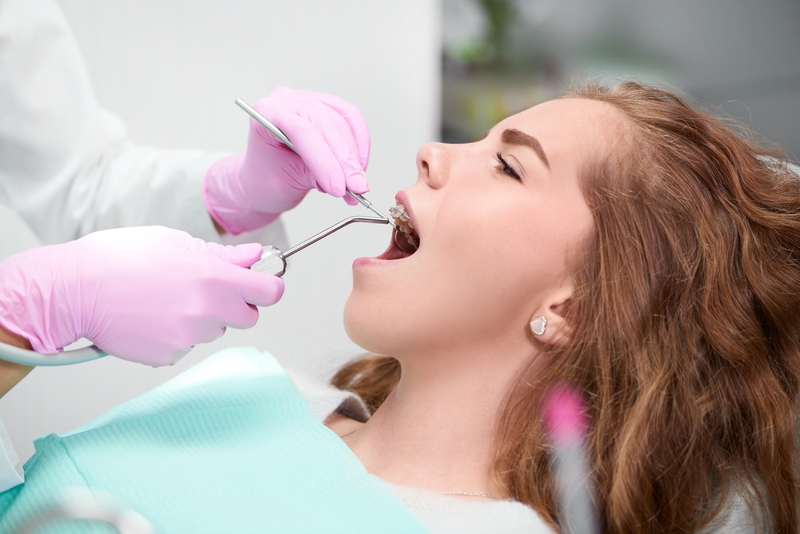
More than half the people that wear braces are children and teens. This can be an exciting time for kids to fix bite problems and crooked teeth. However, tooth decay and oral health problems also run rampant during braces if oral hygiene guidelines aren’t followed. Sometimes children and teens need a nudge to help them with their oral health. Find out what they should be doing to care for their braces during this time!
Facts About Braces
Did you know that there are over 4 million people in the United States each year that wear braces? About 1/4th of those are adults and the rest are children and teens. Patients use braces as teens to straighten the adult, permanent teeth that have come in. When children have child orthodontics, those brackets and wires are meant to correct bite and alignment issues that could cause a child severe problems in the future. Children can then straighten their permanent teeth later on.
There are common oral health problems that many children face today. It’s called tooth decay, and the National Institutes of Health reports that it’s the most “prevalent, chronic disease” among children and adults. 42% of children will have tooth decay before they are 12. 23% of those will have untreated dental decay. About 92% of adults have had tooth decay sometime in their life. The worst part about this is that tooth decay is completely preventable if a child, teen or adult has good oral health through practicing proper oral hygiene.
It may take several years for a child to have the right dexterity in their hands to brush and floss correctly. That is why parents must take care of their child’s oral health when they are young, or it could lead to serious problems. Children rely on parents to help their mouth stay healthy. Even teens need to be told to brush and floss, as it’s something they often forget. These habits are especially important during braces, as oral health is most affected when there are brackets and wires on the teeth.
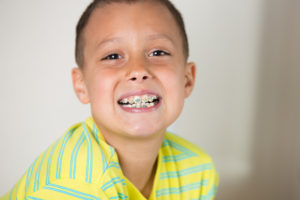
Helping Your Child’s Oral Health
The American Academy of Pediatrics recommends that children see a dentist around 1 year or within 6 months of their first tooth coming in. After that, they should go biannually to the dentist. This is how a dentist can start to see signs of bite and alignment problems, which are then referred to an orthodontist.
With some orthodontic appointments, a child can be fitted for braces to correct problems that are easy to fix with a young, moldable jaw, but hard to fix when a person is older and their jaws are set. Without braces, you will have to help your child brush and floss their teeth at least twice a day as the American Dental Association recommends. Use child toothpaste enhanced with decay-fighting fluoride and a toothbrush that fits the size of your child’s mouth.
Children will need to floss between their teeth, but might have to start out with flossers for kids. With braces, children should be brushing at least twice a day, but after every meal is even better. They should brush at 45-degree angles, making sure to move in all different directions to dislodge food that has been stuck in the braces. Flossing is incredibly important as well, as it gets 40% of tooth surfaces that are missed if flossing is skipped. Help them learn how to use threadable floss. This gets poked through the spaces between their teeth, pulled through, and flossed like you would normally do. Use a Christmas tree brush or a waterpik to help them dislodge stuck food.
Do You Have Good Habits?
One of the best ways to help your child with their oral health is to show them its importance through your own actions. If you don’t brush and floss your teeth, your child or teen may not either. When you’re also not visiting the dentist, odds are that your child isn’t either. If you eat a poor diet full of sugar, then your child will do the same. Children often copy what their parents do.
Make sure you are brushing your teeth at least twice a day, especially when your children can see you. Floss your teeth and teach them how to floss properly as well. When you need to go to the dentist, take your children with you and have them get their comprehensive exams and cleanings. All these oral health measures will ensure their mouths stay clean and healthy for years!
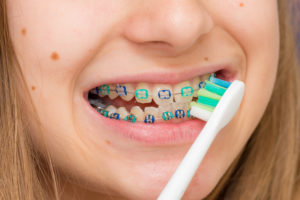
Other Factors to Consider
Your child can brush and floss their teeth often and may still end up with cavities. Cavities come from plaque in the mouth that has set on the teeth for too long. Your mouth makes plaque when you eat sugary foods and that sugar mixes with mouth bacteria to make acidic plaque. That acid is what causes the tooth decay. However, if you limit your sugar intake to begin with, you won’t have the problem with tooth decay.
Unfortunately, sugar is one of the most-consumed substances in the world. It is literally found in almost every food. That is why tooth decay is so common, especially in children. Limit your child’s sugar intake if you want them to have healthy teeth when their braces come off. Teeth that don’t get brushed or flossed often with braces, may end up having cavities, gum disease and eroded areas of their teeth when braces come off.
Their food can also leave them with squares on their teeth from the brackets, because the surrounding tooth has been damaged by food. Make sure to consider what your child is putting in their mouth if you want to help them have good oral health! For more tips or answers to questions about your child’s braces, call Belmar Orthodontics today at (303) 225-9016!
Cavity Treatment During Braces
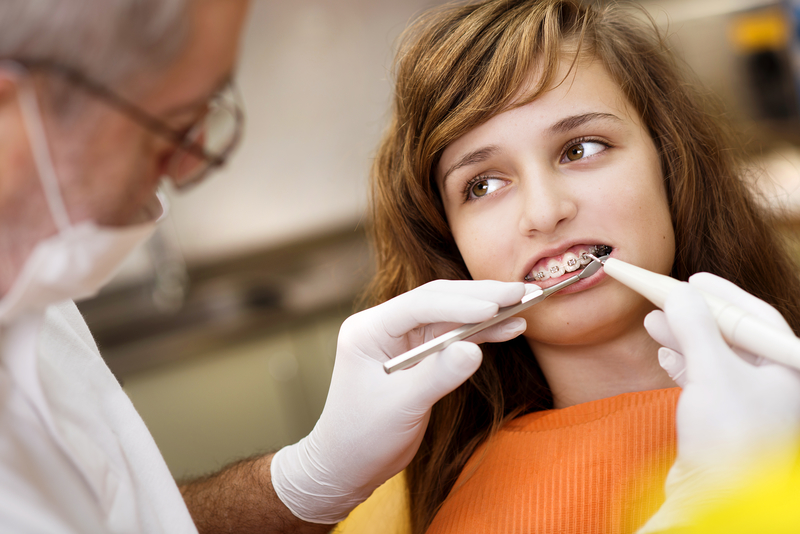
Did you know that an orthodontist and a dentist are not the same? Only a dentist can help with cavities, gum disease and more, while only an orthodontist can straighten your teeth in a certain way. A patient’s time with braces is a time when cavities happen very quickly, because the teeth are harder to clean. To prevent cavities during your time with braces, it is vital that you continue to see a dentist. If you do happen to get a cavity, find out what that cavity treatment will look like!
Proper Oral Hygiene
The American Dental Association recommends that every patient brush their teeth at least twice a day to avoid tooth decay. Brushing after every meal is even better for avoiding plaque buildup that leads to decay. Every patient should also floss their teeth at least once a day. Using fluoride toothpaste is best, because fluoride helps coat the teeth in a protective layer that prevents decay and keeps tooth enamel stronger. Patients can also benefit from mouthwash, as it can kill bacteria that would otherwise create plaque.
However, these recommendations are for people that don’t have braces. Every single person—children, teens and adults—should follow these recommendations. Infants should not use fluoride or mouthwash, but their child toothpastes generally have safe amounts of fluoride in them. If you are a patient that is receiving orthodontic care via braces, you have to go the extra mile with your oral hygiene. That means more frequent brushing, more flossing and watching what you eat.
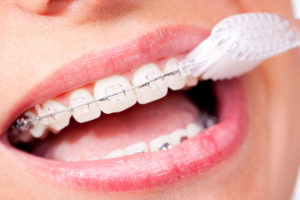
Taking Care of Braces
Braces can be tricky to clean. However, their design provides the best and quickest way for you to straighten your teeth, which is why traditional metal braces have been around for so many decades. Metal braces, ceramic braces and lingual braces all have a brackets-and-wires design.
However, with braces, you must be meticulous with cleaning them or you will have food and plaque get stuck places. If you don’t unstick those substances, they will quickly erode your tooth enamel and cause decay around your appliances. This can happen on every tooth as well.
Follow these tips for cleaning your braces:
- Brush after every single meal. This reduces staining and bacteria buildup. Use a regular soft-bristled brush and brush down from the top, then up from the bottom. Brush in all different directions to dislodge food.
- Use a threadable floss or a floss threader. Both will require that you thread the floss through each space between your teeth. You will have to go under the wire to do this, and it will take slightly longer than normal flossing. This is one of the most important oral hygiene recommendations to follow!
- Use helpful tools. A proxabrush is a small braces brush that can help unstick foods. It looks like a tiny Christmas Tree brush. A waterpik is also helpful. This is a tool that helps blast away food particles with a stream of water.
Tooth Decay with Braces
Many children and teens skip flossing or brushing here and there. Every time you skip on an oral hygiene habit, it increases your risk for tooth decay—or cavities—with braces. Your time with braces is one where you have to be super careful about your oral health. Most people picture their beautiful smile after getting their braces off, but they don’t think about cavities and tooth erosion. You can end up with tooth decay and parts of your teeth that have eroded due to your oral hygiene habits with braces.
Nobody wants to spend 18-24 months perfecting their teeth only to be disappointed in their smile. That’s why oral hygiene is so important. Tooth decay happens rapidly, and it can happen where the brackets are bonded to your teeth and in-between your teeth because it is harder to floss. Normally, you would simply visit the dentist and have your cavity removed and filled. However, cavity treatment is a bit different with braces.
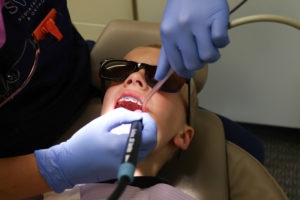
Cavity Treatment with Braces
Cavity treatment is slightly harder if you have braces, but not impossible. Generally, decay happens between teeth cracks and around brackets and wires. If you have tooth decay that is in a tricky spot, we can remove your wire so that a dentist can provide you with a proper cavity treatment. You will have to have your appointments scheduled close together (dentist and orthodontist) so that you can get your cavity filled and your wire replaced.
In severe cases of tooth decay, we may have to remove a bracket from the tooth if it interferes with the dental work that needs to be done. We only do this in certain cases, and we replace the missing part as soon as possible so your teeth don’t move. Cavity treatment—with taking out the tooth decay and filling it—is the same with braces as it is without, only you have to work around orthodontic appliances if you have braces. Always let us know if you have tooth sensitivity, sharp (and even mild) pain when chewing and if you have sensitivity to hot or cold foods. This signals that there may be a more severe cavity.
Prevent Cavity Treatment
The goal of every patient—old and young—is to avoid tooth decay altogether. If you do, you’ll never have to worry about cavity treatment with braces. If your decay is small and in a tricky spot, you may have to wait until your braces are off to receive your cavity treatment. That might make your cavity grow larger, which is something you don’t want. Always see the dentist to check your mouth for tooth decay before you receive orthodontic treatment. This can avoid many problems in the future.
If you are prone to getting cavities or you have weak enamel, consider receiving Invisalign treatment instead of getting brackets and wires. This will help you avoid problems with cavities and needing to get cavity treatment. If you have tooth pain or want to learn more about cavity treatment with braces, call Belmar Orthodontics today at (303) 225-9016!
Sugar Guidelines for Children and Adults

Did you know that the more sugar you eat, the more at-risk you are for cavities? Sugar itself doesn’t necessarily cause a an immediate cavity, but you do get tooth decay because of the effects of sugar on your teeth. That is why it’s so important to brush and floss your teeth every day and to keep your mouth clean. You may be watching your sugar intake, not realizing that you are still going over recommended sugar guidelines. Even diet or “healthy” foods are full of sugar in many cases, which means you might be at a higher risk for tooth decay than you think. Find out what the sugar guidelines are for each age group, what sugar does to your teeth and how you can prevent cavities for both you and your children!
How Does Sugar Affect You?
Sugar can be so sweet, but not when it comes to your teeth or your body. Did you know that sugar does not actually have any nutritional value? It is an added substance that is found in too many foods to name. It’s even found in baby food, meaning even a small baby may be getting too much sugar in their diet. Sugar has damaging effects to children and adults alike. It not only leads to cavities (more about that later), but it can lead to obesity and weight gain, and inability to lose weight, and can increase your risk for diabetes and other chronic diseases. Sugar can be addicting, and the more you eat, the more you crave.
Many people will eat a meal and want to end each meal with something sweet. This is because sugar causes a release of dopamine in your system, which leads to a “feel-good” emotion that people crave. However, sugar also leads to an energy crash, generally within a half hour. Before you think about putting that sugary treat in your mouth, think about how it will affect your teeth and your oral health.
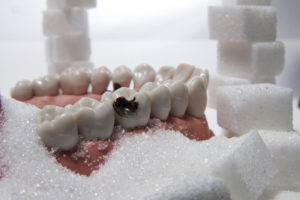
Sugar and Your Teeth
Did you know that sugar is one of the worst substances for your teeth? Your tooth enamel and sugar does not mix well. In fact, sugar actually attacks your teeth in a way. Sugar is found in most foods and drinks that people consume. When you eat, that sugar dissolves and mixes with bacteria in your mouth. That mixture forms a sticky, transparent substance that sticks to your teeth like glue. We like to called this substance plaque, and you might even have some on your teeth right now if you look closely.
The more sugar you eat, the more plaque your mouth will make. Even though plaque is clear, it is acidic in nature. When it coats your teeth, it starts to erode away your tooth enamel. That’s why sugar is such a concern when it comes to your oral health, and why dentists are always recommending patients to limit their sugar intake. More sugar means more plaque, which means more cavities for you. If you start to cut out sugar from your diet, or your child’s you may notice that your child will start to have fewer minor health problems and fewer cavities. If children and adults alike limit the sugar they consume while they have braces, they are much less likely to have eroded or decayed teeth when they get their braces off. Plaque already sticks to the teeth like crazy without braces. With them, it sticks even more and gets into the brackets as well.

Sugar Guidelines for Your Age Group
Did you know that there are sugar guidelines for how much sugar you should eat in a day? Those sugar guidelines don’t only come from a dentist, but countless health institutions. The National Institute of Health and the American Heart Association report that too many people are over-exceeding their daily sugar recommendation by more than double! Men should only be having up to 9 teaspoons of sugar a day, which is about 36 total grams of sugar or 150 calories. Women should only have up to 6 teaspoons, or 25 grams or 100 calories. Children should have little to no sugar and should consume well below 6 grams of added sugars a day.
However, studies show that many people over 18 are consuming an average of 34 grams of sugar a day. Children over 6 are getting 20 grams or more of added sugar a day and even babies 1-3 years old are getting 12 grams or more. It’s no wonder that the NIH reports that tooth decay (known as “cavities”) is the most chronic prevalent disease among children and adults!
Combat Tooth Decay During Braces
You want to be incredibly vigilant with taking care of your oral health, especially with braces. Brush and floss your teeth several times a day. We recommend brushing your teeth after every single meal to get rid of acidic plaque and food particles that get stuck so easily in brackets. Don’t forget to floss your teeth. Use floss threaders to make this part of cleaning your braces easier. Cleaning your teeth only takes a few minutes a day (even with braces) and it’s never something you want to skip.
You’re spending 18-24 months straightening your teeth. You don’t want that beautiful smile to be full of areas of tooth decay and tooth erosion when your braces come off. If you want a beautiful smile, follow the recommended sugar guidelines for your age group. Brush and floss your teeth meticulously and take care of your oral health. If you need help making cleaning your braces easier, call our Belmar Orthodontics office anytime at (303) 225-9016!

